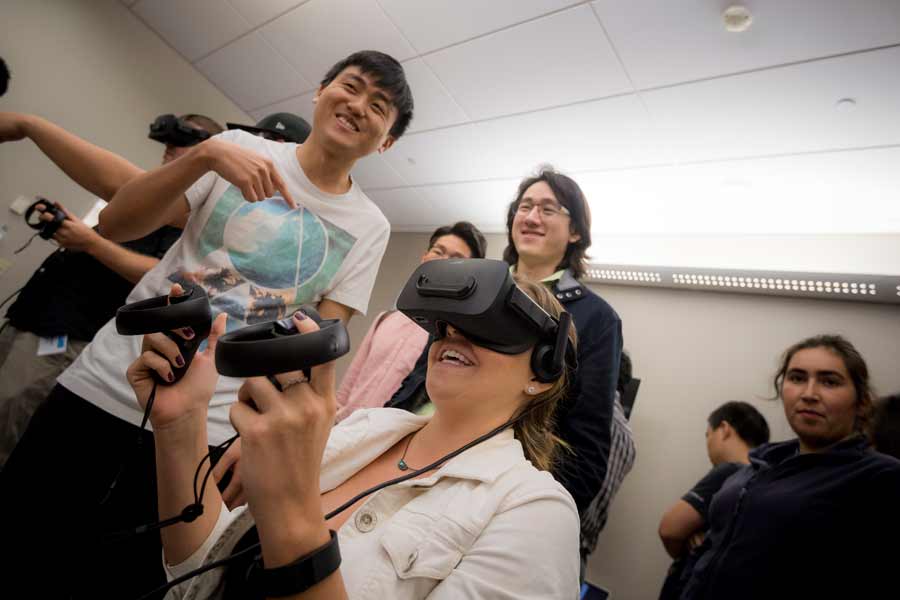Acting Student and Bioengineering Alumna Awarded Soros Fellowship for New Americans
Awards & Accolades
By:
Published Date
By:
Share This:

Photo by Erik Jepsen/UC San Diego Publications
As president of the student-run Virtual Reality Club at UC San Diego, Connor Smith says VR interest is at an all-time high among undergraduate students at UC San Diego. “We were lucky to see anyone here in the lab before winter quarter,” added Smith. “Now, we’re absolutely packed much of the time, and membership will continue surging, particularly from students enrolled in VR courses who get hooked on VR development.”
Until now, club members had to use their own equipment and meet in respective members’ apartments to work on their VR Club projects, including Google and HTC. Now, some members use the VR Lab (when it’s not being used for classes), and the club has raised support from industry: Google gave the VR Club 200 Cardboard-style headsets, and HTC provided two Vive VR systems.
The Computer Science and Engineering department encourages students in the VR developer community. Although currently enrolled students in VR courses offered by the department take precedence when it comes to using lab facilities, VR Club members can use the workstations and head-mounted displays if they’re not otherwise occupied. Indeed, even when all of the individual Oculus Rift workstations are in use, a VR Club team (with an average of 10 students per team) can still use the lab’s HTC Vive system.
“It’s not uncommon for a team of VR Club members to be collaborating in a corner while Schulze’s students are working on their projects at the workstations,” noted Smith.
Some VR Club members also get academic credit for the time they put into developing VR content. Members must commit to working a certain number of hours every week to remain active in the club. For beginners, it’s just 2.5-5 hours, and mid-level members pledge 5-7.5 hours weekly. For advanced students, if they commit to spend over 7.5 hours each week on club projects, they can get academic credit for individual CSE 198 projects with Schulze. (Currently Schulze oversees more than 20 CSE 198 students doing solo projects; most enrolled after taking one of his prior courses.)
In addition to the group projects, VR Club members are constantly doing outreach—particularly to elementary, middle and senior high school classes (most recently at La Jolla Country Day School). For Halloween this year, they expect to invite students from local schools to visit the VR Lab to watch horror-themed VR experiences—giving young people a taste of what the campus will offer more widely when they are old enough to go to college.
The first major event to take place in the VR Lab prior to the open house was the Cyber-Archaeology VR Hackathon. The VR Club co-organized the competition with the Qualcomm Institute-based Center for Cyber-Archaeology and Sustainability (CCAS). The top prize went to a team of undergraduates from CSE and other departments who created an interactive VR app that simulates mining and smelting copper in the 10th century B.C. at a copper producing facility in the Jordanian desert, and experience based on research and excavations carried out in the Jordanian desert.
In early June, the VR Club will host an all-campus showcase in the Price Center Ballroom. They will bring in six or seven HTC Vive systems so that many people can be viewing club projects at the same time. For the two teams that are not developing for the Vive, the club will demo their mobile VR applications using systems including Google Cardboard and Google’s Daydream View (primarily designed for Google’s Pixel smartphone). The Daydream View (which sells for as little as $49) has a built-in controller, whereas the Cardboard (at $15 or less) has no controller.
Share This:
Keep up with all the latest from UC San Diego. Subscribe to the newsletter today.